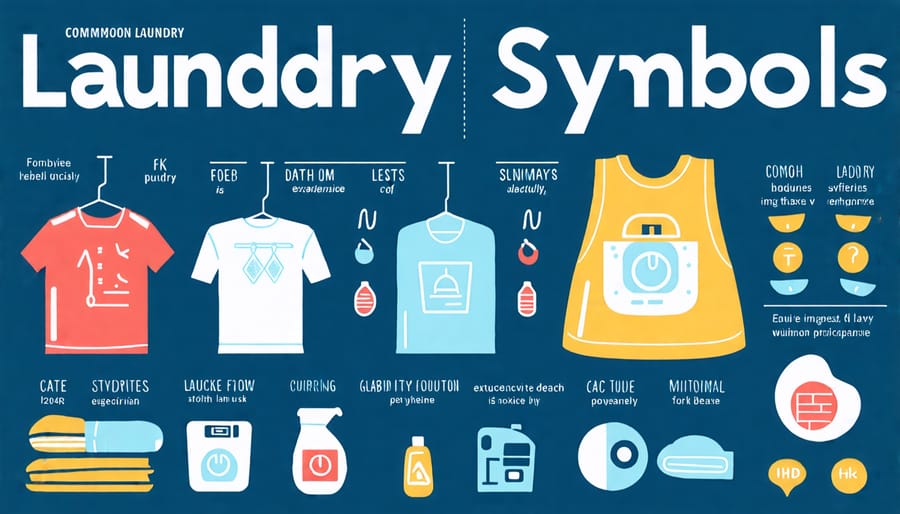Sort your laundry by color, fabric type, and soil level to prevent damage and ensure optimal cleaning results. Use cold water for dark and bright colors to prevent fading, while opting for hot water when washing whites and heavily soiled items to kill bacteria. Choose a detergent that’s suitable for your load type; liquid detergents work well on stains, while powders are effective for general use. Discover additional ways to enhance your home’s comfort by exploring tips that help you create a cozy home. Dry fabrics according to care labels: hang delicate items to prevent shrinking, and tumble-dry sturdy fabrics on appropriate heat settings.
Understanding Laundry Basics
Laundry Symbols Decoded
Understanding laundry symbols on clothing labels is your first step to ensuring your garments live a long, happy life. Imagine these symbols as a direct line to the manufacturer’s care tips. For example, a triangle tells you it’s safe to bleach, while an “X” through it advises against it. A circle suggests dry cleaning; a line beneath hints at a gentle cycle. The infamous washing tub with dots? Those dots are temperature guides, with more dots meaning hotter washes. Taking a moment to decode these symbols can make a big difference in garment care. For more laundry tips, explore comprehensive guides that walk you through the entire process effortlessly.


Choosing the Right Detergents
To elevate your laundry game, choosing the right detergent is key. Different fabrics and stains demand specific solutions to ensure your clothes come out clean and fresh. For delicate fabrics like silk or wool, opt for a gentle, enzyme-free detergent. These formulas protect fibers without causing damage. For everyday cotton and synthetic blends, standard detergents work well, providing effective cleaning for most stains and regular wear.
Stains can be tricky, but there’s a solution for each one. For oily stains, look for detergents with high surfactant levels to break down grease. Enzyme detergents are perfect for protein-based stains, like blood or sweat, as they dissolve these stubborn marks. If brightening whites is your goal, choose a detergent with added bleach or optical brighteners.
Remember, a detergent’s scent and formula might affect those with sensitive skin, so hypoallergenic options are always a safe bet. Personalize your choice based on fabric care labels and your household’s specific needs, ensuring each wash is just right.
Step-by-Step Laundry Process
Sorting and Preparing Clothes
Before diving into laundry, sorting your clothes is essential for keeping them in top condition. Start by separating them by color: whites, darks, and bright colors. This prevents color bleeding and keeps your clothes looking vibrant. Next, consider the fabric types. Place delicate items, like lingerie and silk, in their own pile, while grouping heavier fabrics such as jeans and towels together. This helps protect delicate items from damage.
It’s also crucial to sort by soil level. Heavily soiled garments should be washed separately to ensure a thorough clean while protecting lighter soil clothes from potential dirt transfer. Paying attention to care labels can guide you on any specific washing instructions. By taking these steps, you’ll enhance your laundry routine and help your clothes last longer. Feeling empowered in your laundry skills can make this chore a breeze, leaving you with fresh, clean clothes and a more organized routine.
Washing Techniques for Different Fabrics
Understanding how to wash different fabrics can make all the difference in keeping your clothes looking fresh and lasting longer. Cotton, known for its durability, can usually handle a bit of heat. Set your machine to warm or hot and use your regular detergent, making sure not to overcrowd the load to allow enough space for agitation.
Wool, on the other hand, requires a gentler touch. Opt for a cold, gentle cycle and a mild detergent specifically designed for wool to prevent felting. If you’re up for it, hand washing wool using lukewarm water can also be a safe bet. Just remember to reshape while damp and lay flat to dry, avoiding direct heat.
Delicate fabrics such as silk or lingerie need extra care. Consider using a mesh laundry bag and a gentle, cold cycle. You can also hand wash delicates using a delicate detergent. Avoid wringing to prevent distortion; instead, gently press out excess water with a towel.
With these steps, you’ll not only maintain your fabric’s quality but also enjoy the satisfaction of well-cared-for garments. These simple yet effective techniques ensure each fabric receives the attention it deserves, tailored to its specific needs. Happy laundering!
Drying and Folding Tips
When it comes to drying your clothes, choosing the right method can make a big difference in maintaining their quality. For a natural approach, line drying is fantastic, giving clothes a fresh outdoor scent and being gentle on fabrics. Be sure to hang items where air can circulate freely, keeping colors vibrant and avoiding that crisp, stiff feel. If you’re using a tumble dryer, select the appropriate setting for the fabric type—low heat for delicates and higher heat for sturdier garments to prevent shrinkage. Drying racks are a handy alternative, especially for small spaces. Arrange clothes with enough space between them to allow airflow, reducing wrinkles and drying time.
Folding clothes may seem mundane, but it’s key to keeping your space tidy and making outfits easy to find. Start by folding items while they are still slightly warm from the dryer, as this helps minimize wrinkles. For shirts, fold the sides towards the center, then flip the bottom towards the collar, creating a neat rectangle that fits perfectly in drawers. Towels stack nicely when you fold them in thirds, then in half, maximizing storage. With these methods, laundry becomes less of a chore, and your wardrobe stays organized.
Common Laundry Mistakes to Avoid
Mixing colors and whites is a common laundry mistake that can ruin clothes. Always separate your loads—this simple step prevents dye transfer. Another pitfall is overloading the machine; this can hinder washing efficiency and cause damage. Make sure to leave some space for your clothes to move freely. Incorrect detergent use is also widespread—using too much can leave residue, while too little won’t clean effectively. Always follow recommended doses. Lastly, forgetting to treat stains promptly can set them permanently. Quickly apply a stain remover and wash as soon as possible to maintain your garment’s appearance and longevity.
Advanced Laundry Techniques
Stain Removal Solutions
Navigating the world of stain removal can seem daunting, but it’s all about having a few reliable tricks up your sleeve. For starters, act quickly with any stain—time is your enemy here. Dab, don’t rub, to avoid spreading the stain further. Household heroes like vinegar, baking soda, and dish soap are potent allies against common stains. For instance, a paste of baking soda and water can work wonders on oil stains, while a dash of dish soap might be perfect for tackling food spills. For tougher stains, like wine or coffee, try soaking the fabric in vinegar diluted with water. Commercial products, too, can be helpful, with sprays and gels designed to lift even set-in stains. Always check the product instructions and do a spot test on a hidden area of your fabric. If you’re eager to explore more home-cleaning hacks, look at our cleaning guide for inspiration. With these techniques, you’ll be a stain-removal pro in no time!
Special Care for Linens and Towels
Maintaining the freshness and longevity of your linens and towels is easier than you might think with a few simple tips. First, always separate them by color and fabric weight to prevent damage from rougher materials and bleeding colors. Use warm water for towels to kill bacteria while maintaining their softness, while cold water works well for preserving the color of linens. Avoid overloading the washing machine, as this can prevent thorough cleaning and rinsing.
Incorporate a gentle, fragrance-free detergent to cater to sensitive skin and prevent residue that diminishes fabric absorbency over time. To enhance your towels’ plushness, add a bit of white vinegar during the rinse cycle. This not only softens the fibers but also helps eliminate lingering odors. When it comes to drying, opt for air drying when possible, especially for linen sheets, to reduce wear and tear. If using a dryer, a lower heat setting is your best friend. Hot temperatures can weaken fibers and decrease the lifespan of your fabrics. With these steps, your linens and towels will stay fresh, soft, and beautifully maintained.
Creating an Organized Laundry Space
Storage Solutions for Efficiency
Transform your laundry space into a model of efficiency with creative storage solutions that perfectly blend style and practicality. Start by utilizing vertical space; install shelves above your washer and dryer to keep detergents and softeners within easy reach. Consider using clear glass jars for storing powders and pods, adding a touch of elegance while maintaining visibility. If you’re up for a bit of DIY cleaning, try creating custom shelving to fit in those awkward corners. Incorporate baskets or bins for organizing different laundry essentials, and label them for easy identification. Hang a pegboard to hold frequently used tools like lint rollers and clothespins. By implementing these simple yet effective strategies, you’ll ensure your laundry area is both functional and pleasing to the eye.

Incorporating Aesthetic Design Elements
Transforming your laundry area into a stylish space doesn’t have to be daunting. Start by selecting a calming color palette that complements the rest of your home. Soft pastels or crisp whites with vibrant accents can brighten even the smallest rooms. Incorporate art pieces or framed prints that reflect your personality, adding a touch of elegance and warmth. Storage options like woven baskets or stylish bins keep essentials within reach while maintaining a neat appearance. Consider adding open shelves for laundry necessities, which double as display spaces for small plants or decor items. Lighting also plays a crucial role; opt for chic fixtures that provide ample light and match your aesthetic. With a few thoughtful touches, your laundry area can become a seamless extension of your home’s decor, making laundry day something to look forward to.
Conclusion
Mastering the art of laundry can truly transform your household routine, bringing about a sense of accomplishment and satisfaction. By embracing the simple yet effective strategies discussed, your laundry experience can shift from a dreaded chore to a joyful, efficient process. Implementing these tips not only saves time but also helps maintain the quality of your clothes, ensuring they last longer and feel fresher. Whether you’re a seasoned DIY enthusiast or just starting out on your home improvement journey, these insights are designed to streamline your process, delivering professional-level results from the comfort of your home. Remember, every expert was once a beginner, and with a little practice, these techniques can become second nature. So why not take a load off your hands and try incorporating these ideas into your routine? You’ll soon find that mastering laundry comes with its own set of benefits, making it a rewarding part of your home care efforts.





